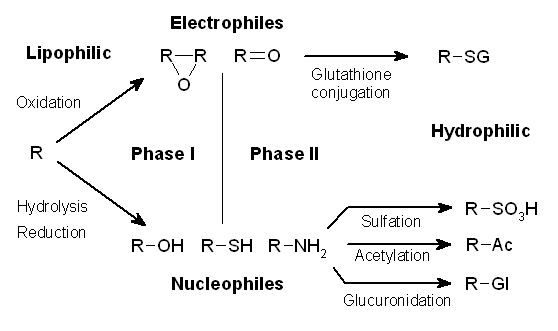|
N-acetyltransferase
N-acetyltransferase (NAT) is an enzyme that catalyzes the transfer of acetyl groups from acetyl-CoA to arylamines, arylhydroxylamines and arylhydrazines. They have wide specificity for aromatic amines, particularly serotonin, and can also catalyze acetyl transfer between arylamines without CoA. N-acetyltransferases are cytosolic enzymes found in the liver and many tissues of most mammalian species, except the dog and fox, which cannot acetylate xenobiotics. Acetyl groups are important in the conjugation of metabolites from the liver, to allow excretion of the byproducts (phase II metabolism). This is especially important in the metabolism and excretion of drug products (drug metabolism). __TOC__ Enzyme Mechanism NAT enzymes are differentiated by the presence of a conserved catalytic triad that favors aromatic amine and hydrazine substrates. NATs catalyze the acetylation of small molecules through a double displacement reaction called the ping pong bi bi reaction. The mech ... [...More Info...] [...Related Items...] OR: [Wikipedia] [Google] [Baidu] |
N-acetyltransferase 2
N-acetyltransferase 2 (arylamine N-acetyltransferase), also known as NAT2, is an enzyme which in humans is encoded by the ''NAT2'' gene. Function This gene encodes a type of N-acetyltransferase. The NAT2 isozyme functions to both activate and deactivate arylamine and hydrazine drugs and carcinogens. Polymorphisms in this gene are responsible for the N-acetylation polymorphism in which human populations segregate into rapid, intermediate, and slow acetylator phenotypes. Polymorphisms in NAT2 are also associated with higher incidences of cancer and drug toxicity. A second arylamine N-acetyltransferase gene (NAT1 N-acetyltransferase 1 (arylamine N-acetyltransferase) is a protein that in humans is encoded by the NAT1 gene. This gene is one of two arylamine N-acetyltransferase (NAT) genes in the human genome, and is orthologous to the mouse and rat NAT2 ...) is located near NAT2. Phenotype prediction The NAT2 acetylator phenotype can be inferred from NAT2 genotype (a com ... [...More Info...] [...Related Items...] OR: [Wikipedia] [Google] [Baidu] |
N-acetyltransferase 1
N-acetyltransferase 1 (arylamine N-acetyltransferase) is a protein that in humans is encoded by the NAT1 gene. This gene is one of two arylamine N-acetyltransferase (NAT) genes in the human genome, and is orthologous to the mouse and rat NAT2 genes. The enzyme encoded by this gene catalyzes the transfer of an acetyl group from acetyl-CoA to various arylamine and hydrazine substrates. This enzyme helps metabolize drugs and other xenobiotics, and functions in folate catabolism. Multiple transcript variants encoding different isoform A protein isoform, or "protein variant", is a member of a set of highly similar proteins that originate from a single gene or gene family and are the result of genetic differences. While many perform the same or similar biological roles, some iso ...s have been found for this gene. rovided by RefSeq, Aug 2011 References Further reading * * * * * * * * * * {{gene-8-stub ... [...More Info...] [...Related Items...] OR: [Wikipedia] [Google] [Baidu] |
Catalytic Triad
A catalytic triad is a set of three coordinated amino acids that can be found in the active site of some enzymes. Catalytic triads are most commonly found in hydrolase and transferase enzymes (e.g. proteases, amidases, esterases, acylases, lipases and β-lactamases). An acid- base-nucleophile triad is a common motif for generating a nucleophilic residue for covalent catalysis. The residues form a charge-relay network to polarise and activate the nucleophile, which attacks the substrate, forming a covalent intermediate which is then hydrolysed to release the product and regenerate free enzyme. The nucleophile is most commonly a serine or cysteine amino acid, but occasionally threonine or even selenocysteine. The 3D structure of the enzyme brings together the triad residues in a precise orientation, even though they may be far apart in the sequence (primary structure). As well as divergent evolution of function (and even the triad's nucleophile), catalytic triads show some ... [...More Info...] [...Related Items...] OR: [Wikipedia] [Google] [Baidu] |
Drug Metabolism
Drug metabolism is the metabolic breakdown of drugs by living organisms, usually through specialized enzymatic systems. More generally, xenobiotic metabolism (from the Greek xenos "stranger" and biotic "related to living beings") is the set of metabolic pathways that modify the chemical structure of xenobiotics, which are compounds foreign to an organism's normal biochemistry, such as any drug or poison. These pathways are a form of biotransformation present in all major groups of organisms and are considered to be of ancient origin. These reactions often act to detoxify poisonous compounds (although in some cases the intermediates in xenobiotic metabolism can themselves cause toxic effects). The study of drug metabolism is called pharmacokinetics. The metabolism of pharmaceutical drugs is an important aspect of pharmacology and medicine. For example, the rate of metabolism determines the duration and intensity of a drug's pharmacologic action. Drug metabolism also affects mu ... [...More Info...] [...Related Items...] OR: [Wikipedia] [Google] [Baidu] |
Phase II Metabolism
Drug metabolism is the metabolic breakdown of drugs by living organisms, usually through specialized enzymatic systems. More generally, xenobiotic metabolism (from the Greek xenos "stranger" and biotic "related to living beings") is the set of metabolic pathways that modify the chemical structure of xenobiotics, which are compounds foreign to an organism's normal biochemistry, such as any drug or poison. These pathways are a form of biotransformation present in all major groups of organisms and are considered to be of ancient origin. These reactions often act to detoxify poisonous compounds (although in some cases the intermediates in xenobiotic metabolism can themselves cause toxic effects). The study of drug metabolism is called pharmacokinetics. The metabolism of pharmaceutical drugs is an important aspect of pharmacology and medicine. For example, the rate of metabolism determines the duration and intensity of a drug's pharmacologic action. Drug metabolism also affects mu ... [...More Info...] [...Related Items...] OR: [Wikipedia] [Google] [Baidu] |
NAT Catalytic Triad
Nat or NAT may refer to: Computing * Network address translation (NAT), in computer networking Organizations * National Actors Theatre, New York City, U.S. * National AIDS trust, a British charity * National Archives of Thailand * National Assembly of Thailand, the national parliament People and ethnic groups * Nat (name), a given name or nickname, usually masculine, and also a surname * Nat (Muslim), a Muslim community in North India * Nat caste, a Hindu caste found in northern India and Nepal Places * Nat, Punjab, India, a village * Nat, West Virginia, United States, an unincorporated community * Greater Natal International Airport, São Gonçalo do Amarante, Brazil (IATA code NAT) ** Augusto Severo International Airport (closed), former IATA code NAT Science and technology Biology and medicine * Natural antisense transcript, an RNA transcript in a cell * N-acetyltransferase, an enzyme; also NAT1, NAT2, etc. * Nucleic acid test, for genetic material * Neonatal alloimmun ... [...More Info...] [...Related Items...] OR: [Wikipedia] [Google] [Baidu] |
4-Aminobenzoic Acid
4-Aminobenzoic acid (also known as ''para''-aminobenzoic acid or PABA because the two functional groups are attached to the benzene ring across from one another in the ''para'' position) is an organic compound with the formula H2NC6H4CO2H. PABA is a white solid, although commercial samples can appear gray. It is slightly soluble in water. It consists of a benzene ring substituted with amino and carboxyl groups. The compound occurs extensively in the natural world. Production and occurrence In industry, PABA is prepared mainly by two routes: * Reduction of 4-nitrobenzoic acid * Hoffman degradation of the monoamide derived from terephthalic acid. Food sources of PABA include liver, brewer's yeast (and unfiltered beer), kidney, molasses, mushrooms, and whole grains. A review on this compound. Biology Biochemistry PABA is an intermediate in the synthesis of folate by bacteria, plants, and fungi. Many bacteria, including those found in the human intestinal tract such as ''E ... [...More Info...] [...Related Items...] OR: [Wikipedia] [Google] [Baidu] |
Active Site
In biology and biochemistry, the active site is the region of an enzyme where substrate molecules bind and undergo a chemical reaction. The active site consists of amino acid residues that form temporary bonds with the substrate (binding site) and residues that catalyse a reaction of that substrate (catalytic site). Although the active site occupies only ~10–20% of the volume of an enzyme, it is the most important part as it directly catalyzes the chemical reaction. It usually consists of three to four amino acids, while other amino acids within the protein are required to maintain the tertiary structure of the enzymes. Each active site is evolved to be optimised to bind a particular substrate and catalyse a particular reaction, resulting in high specificity. This specificity is determined by the arrangement of amino acids within the active site and the structure of the substrates. Sometimes enzymes also need to bind with some cofactors to fulfil their function. The active si ... [...More Info...] [...Related Items...] OR: [Wikipedia] [Google] [Baidu] |
Cisplatin
Cisplatin is a chemotherapy medication used to treat a number of cancers. These include testicular cancer, ovarian cancer, cervical cancer, breast cancer, bladder cancer, head and neck cancer, esophageal cancer, lung cancer, mesothelioma, brain tumors and neuroblastoma. It is given by injection into a vein. Common side effects include bone marrow suppression, hearing problems, including total irreversible hearing loss, usually restricted to one ear, kidney damage, and vomiting. Other serious side effects include numbness, trouble walking, allergic reactions, electrolyte problems, and heart disease. Use during pregnancy can cause harm to the developing fetus. Cisplatin is in the platinum-based antineoplastic family of medications. It works in part by binding to DNA and inhibiting its replication. Cisplatin was discovered in 1845 and licensed for medical use in 1978 and 1979. It is on the World Health Organization's List of Essential Medicines. Medical use Cisplatin is a ... [...More Info...] [...Related Items...] OR: [Wikipedia] [Google] [Baidu] |
Breast Cancer
Breast cancer is cancer that develops from breast tissue. Signs of breast cancer may include a lump in the breast, a change in breast shape, dimpling of the skin, milk rejection, fluid coming from the nipple, a newly inverted nipple, or a red or scaly patch of skin. In those with distant spread of the disease, there may be bone pain, swollen lymph nodes, shortness of breath, or yellow skin. Risk factors for developing breast cancer include obesity, a lack of physical exercise, alcoholism, hormone replacement therapy during menopause, ionizing radiation, an early age at first menstruation, having children late in life or not at all, older age, having a prior history of breast cancer, and a family history of breast cancer. About 5–10% of cases are the result of a genetic predisposition inherited from a person's parents, including BRCA1 and BRCA2 among others. Breast cancer most commonly develops in cells from the lining of milk ducts and the lobules that supply these ... [...More Info...] [...Related Items...] OR: [Wikipedia] [Google] [Baidu] |
Sulfamethoxazole
Sulfamethoxazole (SMZ or SMX) is an antibiotic. It is used for bacterial infections such as urinary tract infections, bronchitis, and prostatitis and is effective against both gram negative and positive bacteria such as ''Listeria monocytogenes'' and ''E. coli''. Common side effects include nausea, vomiting, loss of appetite, and skin rashes. It is a sulfonamide and bacteriostatic. It resembles a component of folic acid. It prevents folic acid synthesis in the bacteria that must synthesize their own folic acid. Mammalian cells, and some bacteria, do not synthesize but require preformed folic acid (vitamin B9); they are therefore insensitive to sulfamethoxazole. It was introduced to the United States in 1961. It is now mostly used in combination with trimethoprim (abbreviated SMX-TMP). The SMX-TMP combination is on the WHO Model List of Essential medicines as a first-choice treatment for urinary tract infections. Other names include: sulfamethalazole, sulfisomezole,PubChem"Sul ... [...More Info...] [...Related Items...] OR: [Wikipedia] [Google] [Baidu] |



